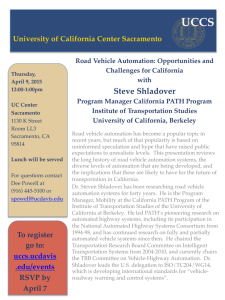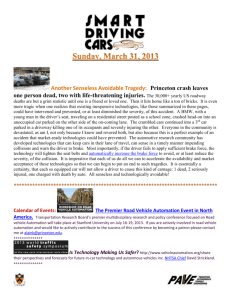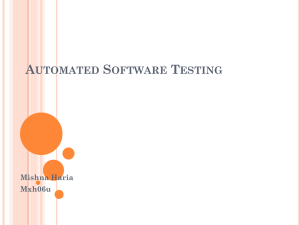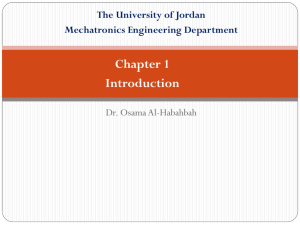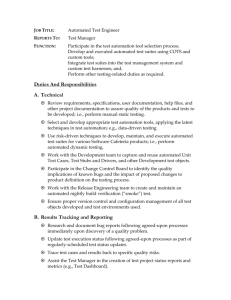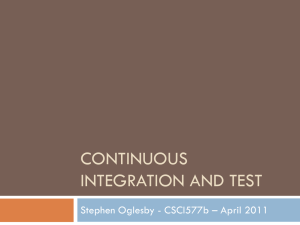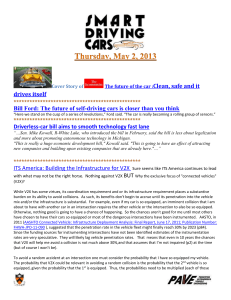ITFVHA13_US_TRB_Workshop_Shladover
advertisement
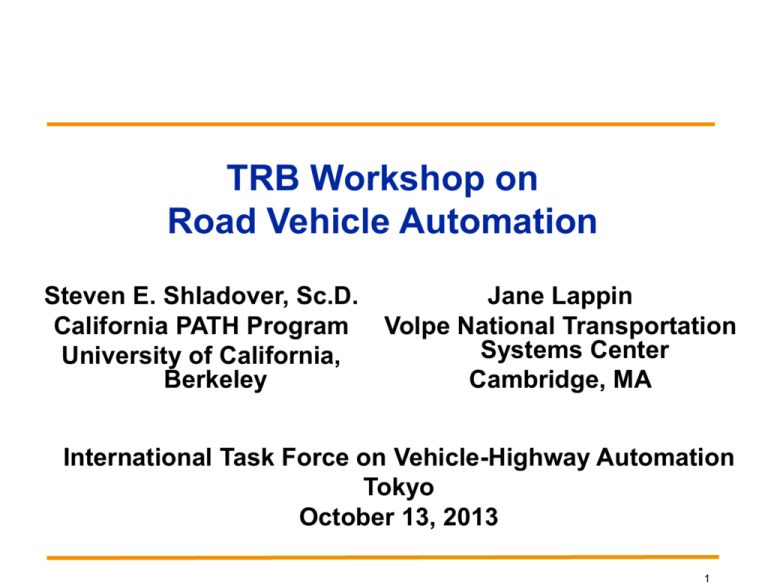
TRB Workshop on Road Vehicle Automation Steven E. Shladover, Sc.D. California PATH Program University of California, Berkeley Jane Lappin Volpe National Transportation Systems Center Cambridge, MA International Task Force on Vehicle-Highway Automation Tokyo October 13, 2013 1 Workshop Overview • July 16-18, 2013 at Stanford University • 335 attendees from 14 countries • Sponsored by TRB Committees on: – Vehicle-Highway Automation – Intelligent Transportation Systems – Vehicle User Characteristics – Emerging Technology Law – Transportation Energy – Cyber Security – Major Activity Center Circulation Systems – Emerging and Innovative Public Transportation and Technologies 2 Workshop attendance 3 Breakout Discussion Topics Identifying Research Needs in: • Automated Commercial Vehicle Operations • Infrastructure and Operations • Cybersecurity and Resiliency • Liability, Risk, and Insurance • Data Ownership, Access, Protection, and Discovery • Shared Mobility and Transit • Testing, Certification, and Licensing • Energy and Environment • V2X Communications and Architecture • Human Factors and Human-Machine Interaction 4 Automated Commercial Vehicle Operations • Definition of commercial vehicle applications for automation and estimating their benefits • Dynamic optimal truck platoon structures (how to sequence trucks in a platoon) • Automated commercial vehicle training for drivers 5 Infrastructure and Operations 6 Cyber-security and Resiliency • Incorporating the hacker mentality into automated road vehicle cyber-security research • Defining cyber-security resiliency frameworks for road vehicle automation and roadside infrastructure 7 Liability, Risk and Insurance 8 Data Ownership, Access, Protection and Discovery • End-User Privacy Perception • Privacy Notices at the Testing Stage • Consumer Privacy Notices by Levels of Automation • Automated Vehicle Data Disclosure • Models for Handling Data Collected from Automated Vehicles 9 Shared Mobility and Transit • • • • • • • • • Evaluate impacts of automated valet parking on land use and transportation demand Evaluate impacts of automated driving on mobility impaired travelers Develop technical basis for international legal framework for certifying automated vehicles Integrate automation and shared mobility into the urban fabric Define common performance measures for automated shared mobility services Estimate additional benefits from high automation on segregated guideways rather than in mixed traffic Assess implications of widespread use of SAE Level 5 automation for transportation planning and design Develop generic hazard analysis framework for automated transit systems Develop collision avoidance system for transit buses 10 Testing, Certification and Licensing • How to identify relevant automation use cases • Comparison of automated vehicle evaluation • • • • methods (test track, road and simulation tests) Incorporation of human responses into testing Potential for testing, certification and licensing requirements to become barriers to market entry Representing real-world environment and driving behavior to improve simulation fidelity Ethical dilemmas in pre-crash decision making 11 Energy and Environment • Transportation Demand Effects—Passenger and Freight • Vehicle Design Changes Facilitated by Automation • Actions to Improve Environmental and Energy Impacts of Automated Vehicle Systems 12 V2X Communications and Architecture • V2X as a Means to Virtually Extend Sensor Range and Coverage • Models and Simulation of Benefits of V2X Integration in Vehicle Automation • V2X Communications Quality of Service 13 Human Factors and Human-Machine Interactions • Transfer of control from higher to lower automation levels • Optimal communication of automated vehicle status information to user • Understanding potential misuse and abuse of road vehicle automation • Driver adjustability of automated driving 14 Next Steps • Research Needs Statements (RNS) drafted by breakout session organizers • RNS adopted by TRB committees (one or more) and entered into TRB online database • Available for use and reference by all interested parties: – Public and private sector research sponsors – System developers and evaluators – University research groups and students – Individual researchers or entrepreneurs 15
